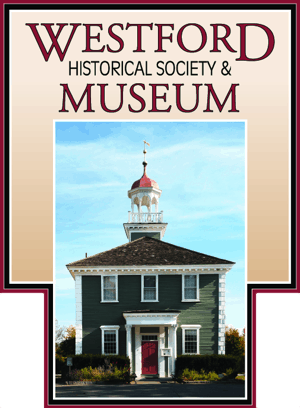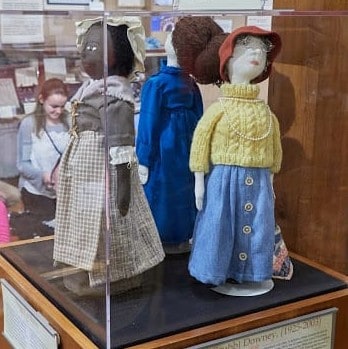
Westford has an abundant history of outstanding and courageous women. Jean Downey (1925-2003) conducted the Westford Women Doll project in 1985 to highlight women’s history and civil rights within Westford, with 12 women originally highlighted. A prominent resident in town, Jean was a nurse, involved with charities, and an accomplished seamstress. A doll in her likeness was later incorporated into her exhibit.
Women throughout Westford’s history have stood up for what they thought was right, whether it be improving the school system, blocking/advocating undesirable businesses in town, volunteering on a Town board, or improving the lives of individuals in some way.
Slavery was in Massachusetts and in Westford until it was abolished in 1783. Although not as vital to the economy as it was in southern states, it was common among wealthier families. Fourteen slaves were baptized by Rev. Willard Hall between 1732 and 1761. In public records, slaves were referred to as “servants”. About a hundred men were directly involved in the Civil War, but women also made their contributions on the home front and during reconstruction.
The Westford Remembered Doll project began as a fundraiser by Jean Downey and other needlewomen of the First Parish Church in 1985. They created doll likenesses of 12 historic Westford women. The needlewomen researched and wrote biographical papers of all twelve women, and credited the program with launching the study of Westford women within the formal Westford school program.
Our Dolls represent the following Women from Westford History…
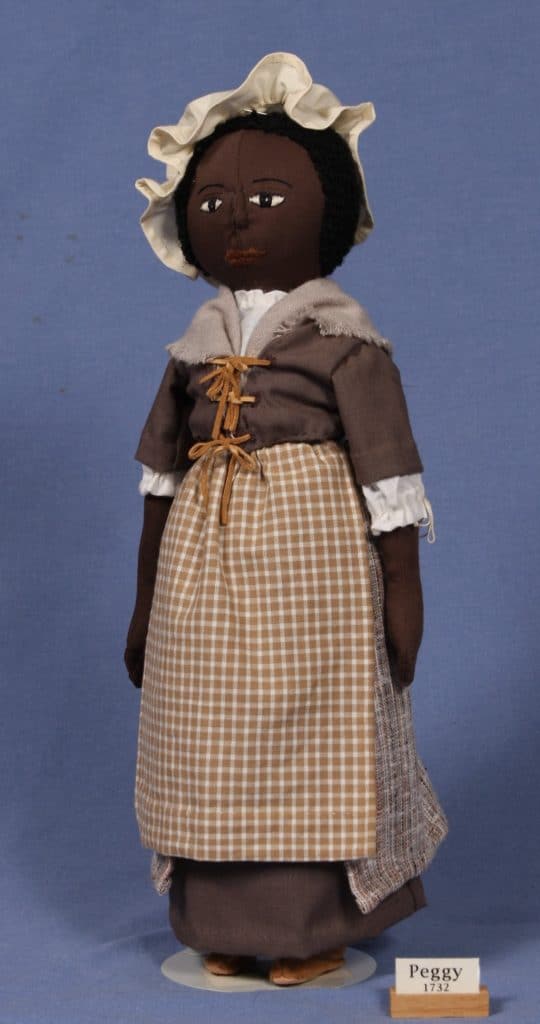
Peggy,
Peggy was a slave, although no record of her birth or death exists, church records show Peggy was baptized in the First Parish Church in 1732. She was the servant of Westford’s Joseph Hildreth, Jr., who lived with his family near Minot’s Corner. Baptisms meant that she could receive Christian instruction and attend church services. However, she had to sit in the gallery or in a rear corner seat.
She likely became part of the Puritan family household, wore used clothes, and helped with family chores and care of the Hildreth children. Hildreth, like other Westford men, was taxed for property, livestock and slaves.
There is no record of burial sites for Blacks. If Peggy died in town, she may have been buried in an orchard or along a wall.
Mary “May” Atwood, (1860-1951)
Born in Westford, the youngest child of Daniel and Caroline M. (Carlton) Atwood. Mary entered Westford Academy in 1874. The family lived for several years at Nashoba Farm on the corner of Hildreth Street and Concord Road. The Atwood’s then moved to the large Victorian house at 4 Graniteville Road. Mary’s three single sisters lived there for many years. It is occupied by the grandson of Daniel Elliott Atwood. The wealthy family wintered in Florida taking a boat from Boston to their destination.
In 1896, Charles L. Hildreth and his daughter donated a Ryder pipe organ to the Union Congregational Church (now the Parish Hall). Hildreth underwrote organ lessons in Boston for Mary so she could perform on the new organ. Otis Day remembers his boyhood job of pumping to fill the organ air chamber for choir practice on one weekday evening and on Sunday mornings.
Otis was paid ten cents a week, but Mary is said to have played for nothing.
Mary Atwood endowed the J.V. Fletcher Library with a generous sum to set up a lecture fund. The Mary Atwood Lecture Hall is named for her. In 1951, she died in St. Petersburg, Florida at age 90. Her body cremated and the ashes interred at Fairview Cemetery.
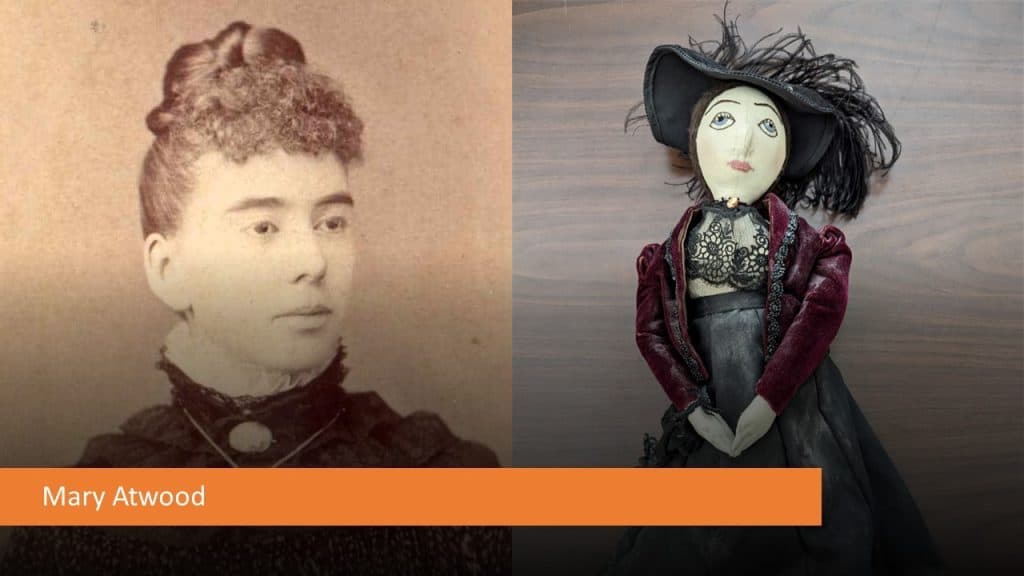
Born in Westford in 1783, the daughter of Jonathan and Mary Proctor Carver, Sally entered the first class at Westford Academy in 1792. At the age of 9, she was the youngest child in the class. Sally’s mother’s family was among the earliest white settlers of Westford.
Sally’s father was a founder, trustee, and treasurer of Westford Academy which demonstrates the Carver roots in education. Sally received an award from one of her teachers which was a little book with wooden covers entitled “Entertaining Histories”. There is no record of Sally graduating from WA or of her marriage to Theodore Peabody. The Carvers moved to Ashby but did return to Westford. They had 3 children, all born in Westford. Sally Carver died on September 2, 1837 at the age of 53.
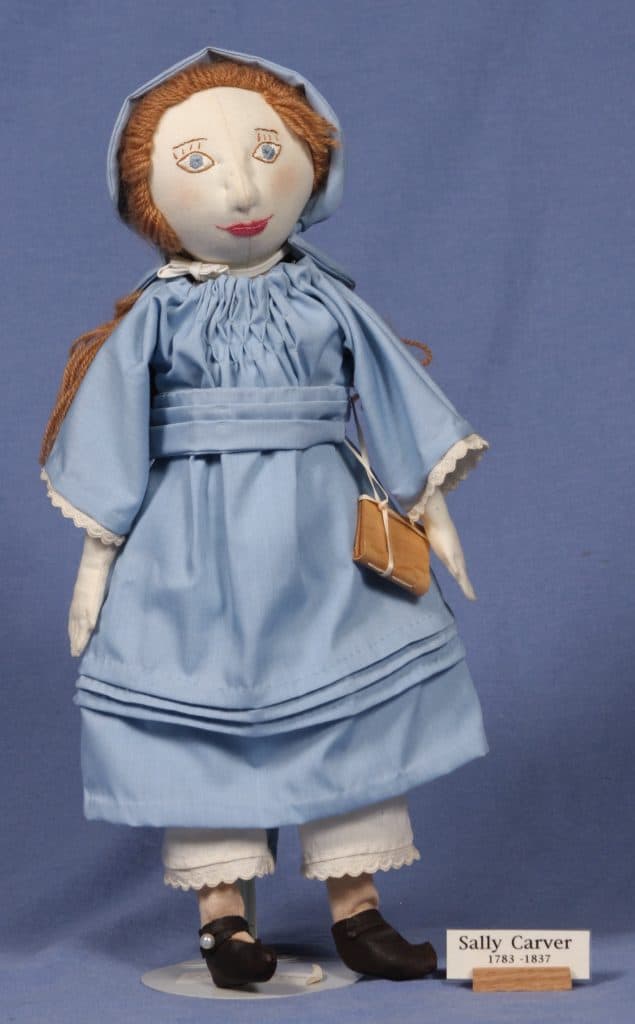
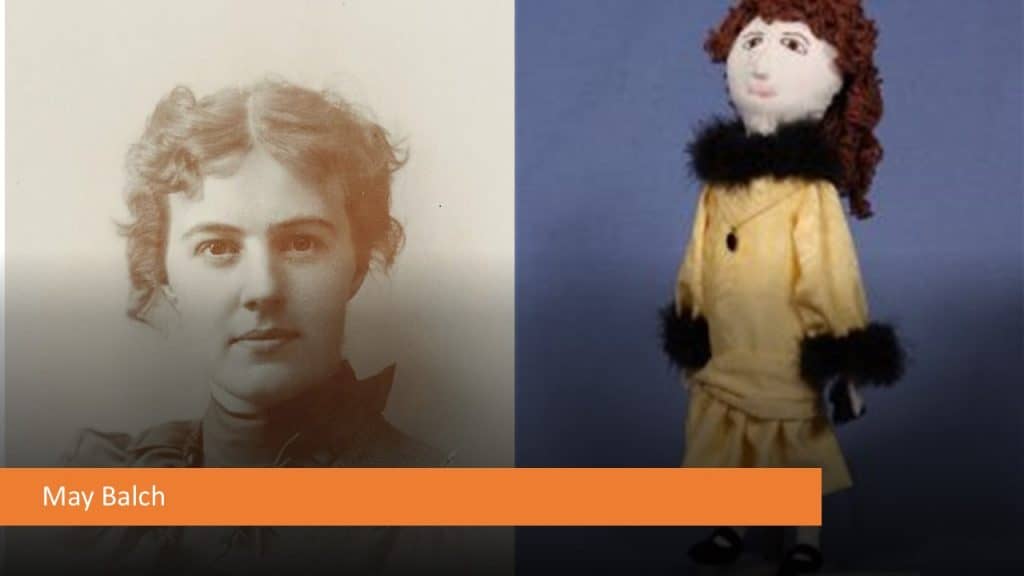
Mary Gertrude Balch “May” (1875-1961)
Born in the Parkerville section of Westford in 1875. May graduated from Westford Academy and later from the Massachusetts Normal Art School in Boston in 1896. She was an artist-painter-designer who painted greeting cards, designed and made dresses, and costumes. She also wrote a novel, “The Stronger Light”, which was published in 1922.” Miss Balch also wrote poems, and some music. Her painting of the original Westford Academy building is on the museum wall above the store shelves.
Mary Balch’s long elaborate, yellow flowered dress she made for graduation from Massachusetts Normal School still survives as do many of her water color paintings, and greeting cards.
Later, she became the supervisor of drawing in the South Hadley school system until the death of her mother, when she returned to Westford to care for her father, Wayland Balch, a Civil War veteran.
“May” participated in the 1929 historical pageant celebrating the 200th anniversary of the incorporation of Westford.
Jean Downey, (1925-2003)
Born in Rocklane, Indiana on a dairy farm. She received an R.N. degree at the University of Indiana, and joined the Cadet Nursing Corps during W.W.II. Jean completed her nurse’s training with a specialty in psychiatric nursing.
Jean and her husband, Rev. George Downey, were involved in civil rights and race relations before these movements were popular.
In 1967, the Downey’s moved to Westford with their 5 children, where George served as minister of the FPCU for 21 years. During her tenure in Westford, Jean worked on several projects, most notably the box project to fight poverty in rural Mississippi. She also served on Human Services Committees while a Westford resident.
Jean is the 13th Westford Woman remembered with a doll created in her likeness.
Emily Frances Fletcher (1845-1923)
Daughter of Sherman Dewey Fletcher and Emily Augusta Fletcher. In 1848, her father built the house that is now 33 Main Street, next door to Ellen & Mike Harde’s current home. Emily grew up in this home along with her siblings Sherman H. & Cornelia.
In 1873 her brother Sherman took over his father’s interest in a small general store (now 40 Main St.) and it became known as the Wright and Fletcher Store. Emily lived on the second floor. She entered Westford Academy at the age of ten and pursued her interest in nature that lasted into her adult years. She scratched through Australian wool waste at Westford Depot looking for specimens of foreign grasses and became an accomplished taxidermist. Some of her bird collection is stored at the J.V. Fletcher Library. Emily’s large collection of dried specimens from Westford is housed at the Gray Herbarium at Harvard University.
Emily Fletcher was Westford’s first recorded woman botanist.
Emily was a Sunday school teacher of boys and a member of the choir in the Unitarian Church. She died on April 13, 1923. She was first cousin twice removed from J.V. Fletcher.
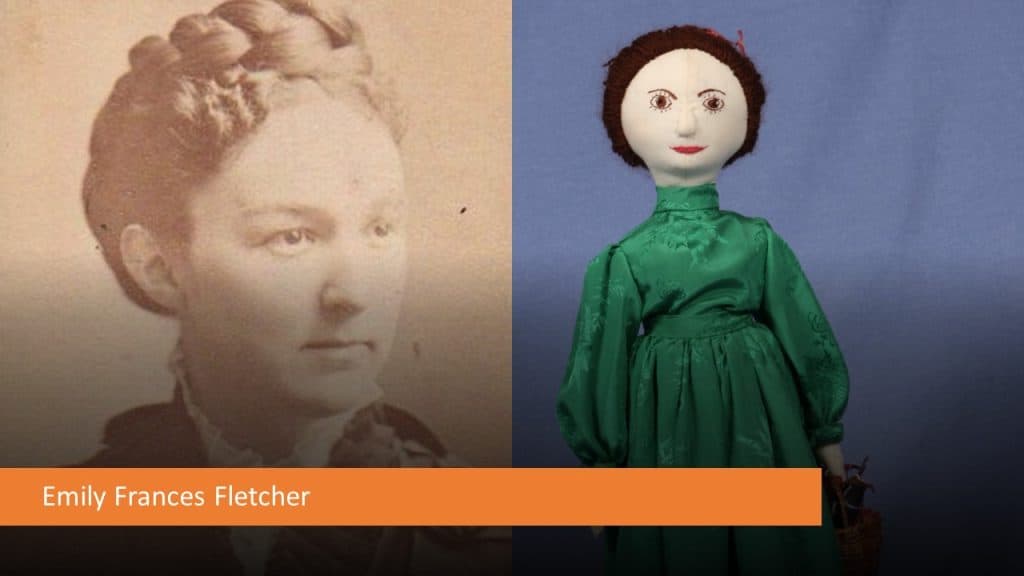
Sarah Elizabeth Keyes, (1839-1866)
Sarah Elizabeth Keyes was born in Westford in 1839; her ancestors were probably the earliest European settlers in the bounds of Westford (1664), residing on Francis Hill Road. She was the youngest of 13 children of Imal and Hannah Fletcher Keyes.
Sarah entered Westford Academy in 1852 and became a teacher. As a representative of the Westford Freedman’s Aid Society she went to Kinston, North Carolina at the close of the Civil War in October 1865 to teach freedmen, slaves emancipated as a result of the Civil War. After much hardship, Sara became ill (consumption), died there on June 5, 1866 at the age of 26 years and 11 months, and was buried in Kinston. Her brother Edward was a soldier in the Civil War and died before he could return to Westford. Sara and Edward are both memorialized in the Nuttting (Hillside) Cemetery.
Emily McNiff, (1894-1987)
Born in Keighley, Yorkshire, England in 1894 where she worked in textile mills starting at age 12. Developed scarlet fever while working in mills but did recover. Immediately after her recovery Emily and her family (nine younger siblings) sailed to Boston. The family arrived in 1908. Upon arrival to the United States the appointed agent did not claim them and they were threatened with deportation.
However, Forge Village sisters Annie and Mary Walsh who worked in the mill took their collective bank books to Boston proving to immigration officials that they could support the McNiff family until they were self-sufficient.
The Abbot Worsted Company sponsored large immigrant families with the expectation that the children would work in the mill as soon as they were old enough.
Emily began work at the Abbot Worsted Co. at age 15. She worked 10 hours per day, 6 days a week and received $ 4.80 per week. All her siblings worked there as well.
At age 40, she married Joseph Blott,. There were no children. She worked at the Abbot Company until it closed and later worked at American Can in Maynard. Emily worked through her sixties and into her seventies. She is remembered as a beautiful woman with a sense of style.
Emily was 93 when she died, she was Mickey Crocker’s aunt.
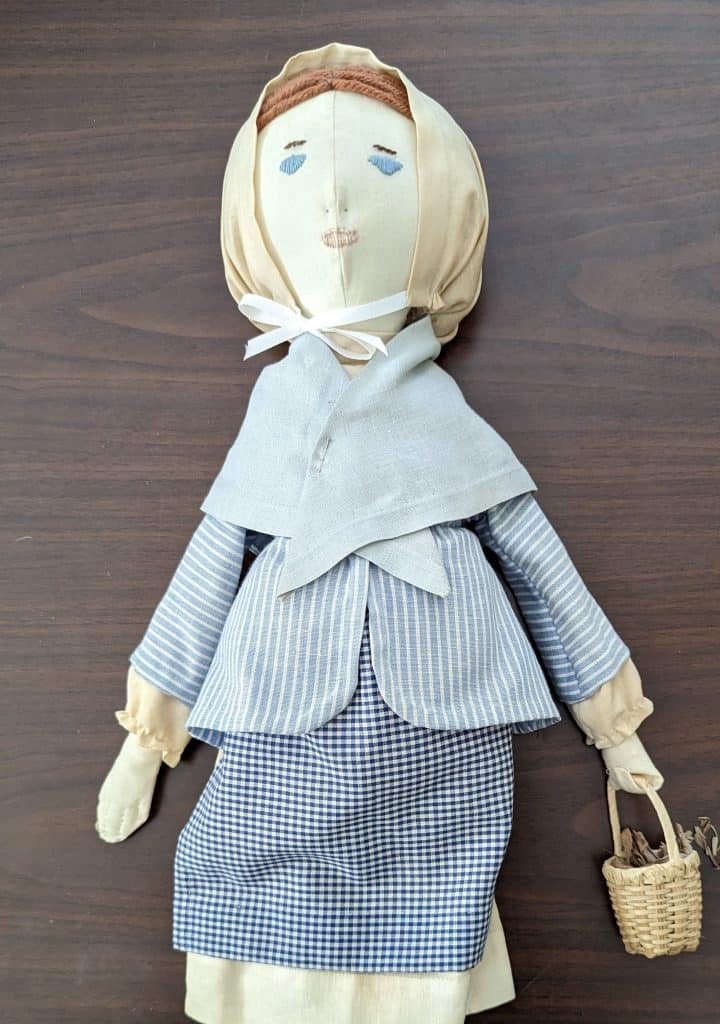
Eldress Lucy Prescott, (1765-1845)
Born in Westford, 9th of 13 children, daughter of Oliver and Bethiah (Underwood). Baptized by Reverend Willard Hall, minister of the town parish. In 1782, Mother Ann Lee, founder of the Shaker movement came to Harvard, MA to preach to religious people at the Square House on the common. Lucy and other women from town would walk 12 miles to hear the charismatic woman preacher. Lucy, her mother, and sister listened and were deeply influenced.
It was worth noting Lucy’s maternal grandfather Joseph Underwood a farmer with substantial wealth was a charter member of the Second Church of Chelmsford and a man of authority with whom Rev. Willard Hall continually quarreled. This is notable to Lucy’s story since a number of church members in 1735 missed public worship because they met at the home of the Underwoods to hear a Lay-Exhorter named Paine, from the Colony of Connecticut. Records show that both Lucy and sister Martha, who was born in 1767, were admitted to the Harvard Shaker family in 1791.
In 1793, Lucy was commissioned second eldress on the first Maine Shaker Ministry, a body of two elders and two eldresses who served as spiritual leaders of the community. Lucy served in this capacity through much hardship until 1830, when she resigned. Her mother, Sister Bethliah, is buried in the Shaker Cemetery in Harvard. Lucy died in 1845 at Watervliet, N.Y., where her sister Hannah and Mother Ann Lee were already at Rest in the Shaker Cemetery.
Olive Adams Prescott, 1780-1860
Born in Chelmsford in 1780, but spent most of her life in the Forge Village section of Westford. Married Abram Prescott (a widower with a small child) at age 21, the couple had 10 children. There are no written records of Olive Prescott’s life and activities, so little is known of her personality. But in considering the life and work of Olive Prescott one must consider the era in which she lived. Living from 1780 until 1860, she was part of a generation which experienced tremendous social and cultural change as the United States grew from an agrarian to an industrial nation. Olive created beautiful woven textiles in wool, linen, and cotton using traditional patterns she probably learned from her mother. Thirty of her textiles are stored in the Peabody Essex Museum and many have won awards at fairs. In fact, she won first prize at the Middlesex County Agricultural Fair in 1824. In considering Olive’s life, there are important questions to ask about her and other women of her era. What did her life consist of in the small town of Westford? What was her role in her community and in her family? What was her economic contribution as a professional hand weaver in a growing industrial economy? Many of these questions can only be answered by inference by studying community and family patterns of the early nineteenth century.
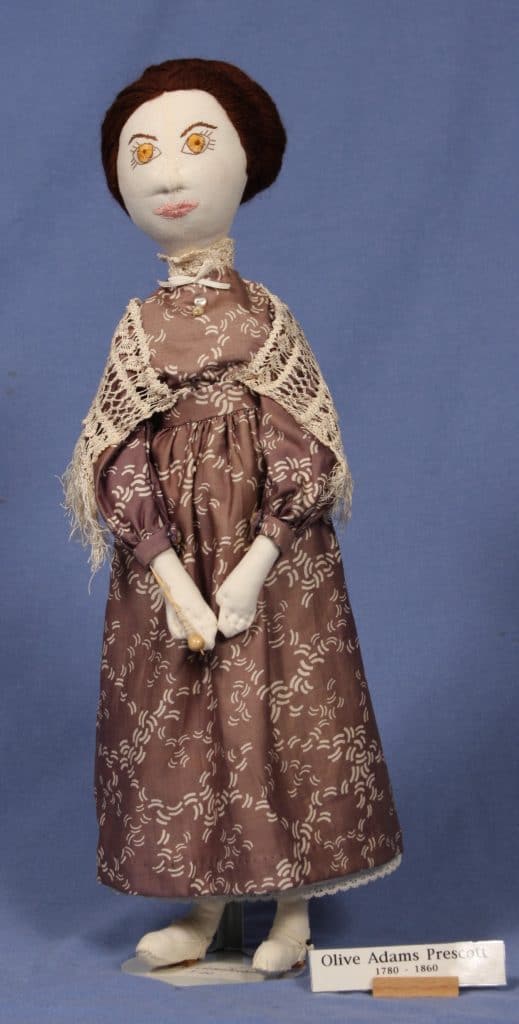
Nettie Maria Stevens, (1861-1912)
Born in Cavindish, VT to Julia (Adams) and Ephraim Stevens, a town settled by Westford men in 1762. After her mother died, the family moved to Westford when Nettie was a young girl. She attended Westford public schools and was considered an exceptional student, graduating in 1880. After completing courses at Westfield Normal School (now Westfield State University), she became a teacher at Minot’s Corner School, District # 6 (1883-84) and at Westford Academy (1884-92.) where her teaching duties included courses in physiology, zoology, mathematics, Latin, and English. She earned an A.B. and M.A. at Stanford University and ultimately a Ph.D from Bryn Mawr in 1903.
Noted for her contributions to research on chromosomes and heredity (i.e .genetics), she is credited with linking X & Y chromosomes to sex determination in 1905. With 38 publications, Nettie was one of few women to achieve recognition for scientific research at that time.
Nettie Stevens died or breast cancer in Baltimore at age 51 and is buried in Westford. There is a building named after her at Westfield State University.
Ellen Henrietta (Swallow) Richards (1842-1911)
Ellen’s family moved to Westford moved to Westford from Dunstable so that she could attend WA. Her family operated a general store in the Center. She graduated from WA in 1862. Particularly interested in nature studies, making maps, drawing and descriptions of Westford topography, streams, plants, and animal life, she was called an “ecofeminist.”
She received an A.B. and M.A. from Vassar College, and in 1870 Ellen was admitted to MIT as a special student in chemistry. Ellen became the first woman to graduate from MIT and worked at MIT as the first female instructor until 1883. Ellen married a colleague Robert Richards in 1875. Ellen Swallow Richards was a leader in air and water sanitation, home sanitation, euthenics. She christened the science of “Oekology” (ecology), founded the American Home Economics Association, and the organization now known as American Association of University Women. She greatly influenced the cause of women’s rights and scientific education
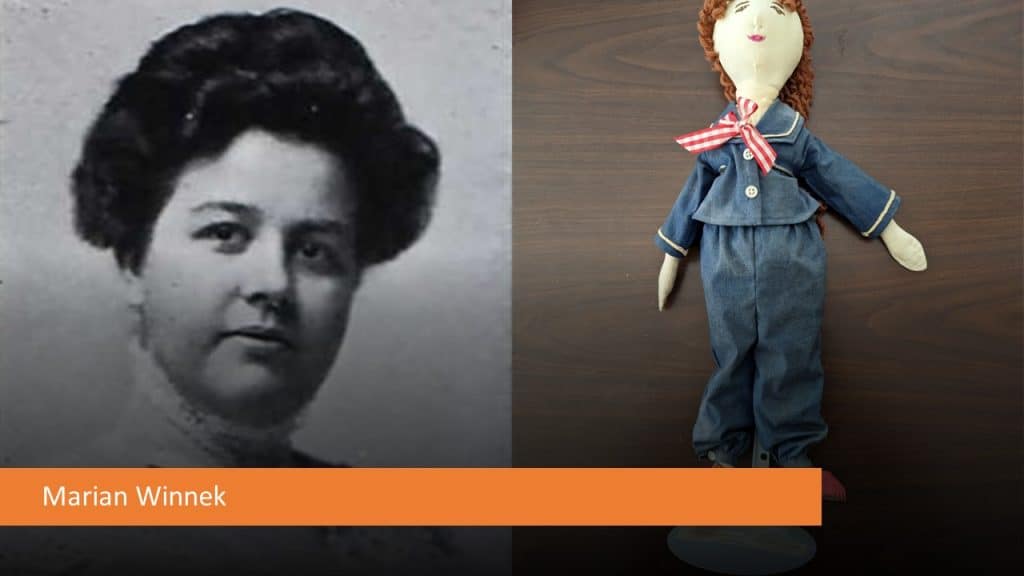
Marian Frances Winnek, 1883-1977
Marian spent summers her summers at Coldspring Farm in Westford where her grandparents lived. Her doll is copied from a snapshot of Marian in her bicycle bloomers, circa 1896. Born in Belmont, MA, the first great-grandchild of J. Varnum and Marcy Hill Fletcher. She graduated from Radcliffe in 1909, and in 1914 earned her Master of Arts degree. During the 1920’s Marian lived in the artists’ colony of Sante, Fe, New Mexica. There she wrote her autobiographical novel “Juniper Hill”, which centered around family summers at Coldspring Farm. She gave the first children’s room to the J.V. Fletcher Library, and more than 30 acres at the base of Prospect Hill to the town of Westford
Wine with the Wild Women of Westford
Through History, Westford Women have been Legendary. Come hear the stories of 5 women from Westford Museum Doll Collection while sipping wine. Saturday August 25, 2023 @7:30pm at the Westford Museum. Hosted by the Westford Historical Society. For ticket information follow link to Wine with the Wild Women of Westford

Information taken these short biography were prepared by the ladies from the First Church United which is on file at the Westford Museum.
